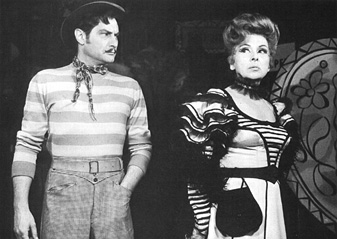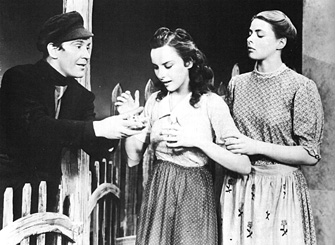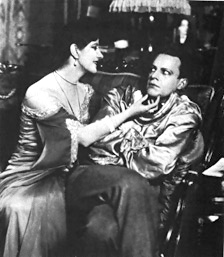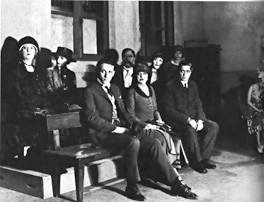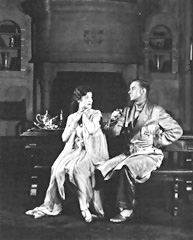Ferenc Molnár |
||||||||||||||||||||||||||||||||||||||||||||
The Play's the ThingReproduced from "The Grapevine" - used with permission Ferenc Molnár (1878-1952), probably the greatest playwright to come out of Hungary, was celebrated all over the world at the height of his fame in the 1920s and 30s, but is now best remembered in the West for the play - Liliom - on which Rodgers - Hammerstein's Carousel is based, and for adaptations of his farce The Play's the Thing by P.G. Wodehouse and Tom Stoppard (the latter as Rough Crossing). Theatre buffs will also remember Judi Dench, Leo McKern and Edward Woodward in a West End production of The Wolf, a National Theatre production of The Guardsman with Diana Rigg for Molnár's centenary and a new musical at the Donmar Warehouse last year based on The Guardsman. In his native Hungary, Molnár has been a neglected figure for years, thanks to the banning of his plays by the communist regime, but a strong revival has sprung from Budapest, his home city, and the time has surely come for theatre directors worldwide to look anew at Molnár's plays with their Freudian and farcical slants on everyday social and romantic situations. To help introduce Molnár to our readers, we spoke to Matyas Sarkozi, the playwright's grandson, himself a writer resident in London, and asked him to lead us into Molnár's world. An 'international' playwright
"The fact that he is an 'international' playwright is important. For Molnár, you don't have to know anything about Hungary, or the Hungarian way of thinking, the Hungarian character, or the big Hungarian soul. His plays are very internationally presentable, because they are on basic themes like jealousy, relationships between men and women. Molnár was a part of the Belle-Epoque, what we think of as "the good old days", pre-First World War." "He was accused by the Hungarian critics of being un-Hungarian - which he denied - and although he was very successful outside Hungary, especially in America, his plays are actually very Austro-Hungarian, very much inspired by the social life of Budapest. Josefstadt, Budapest District No. 8, was said to be a constant inspiration to playwrights and Molnár, often went to this part of the city and sat around in dingy wine bars listening to people telling stories. From this, he came to know a lot about the underworld and also the slang of the day, which he used in his plays. This was novel and very popular." "More than all of this, though, the happenings of his private life almost always were connected with his plays, and that's important from a theatrical point of view." This points us towards plays like Liliom, clearly linked to Molnár's short-lived first marriage, The Devil, which sprang from his fascination with a young actress, and The Play's the Thing, based on an amusing incident that occurred while Molnár and his third wife, another actress, were staying in Vienna."
Early successWe touch on the subject of Molnár's breakthrough. "He studied criminal law and became a journalist, the full-time Paris correspondent for a Budapest paper. In 190 I, his first book, The Hungry City, was published, a story of dirty politics, corruption, social inequality and anti-semitism, and it made him the darling of Budapest café society. Then a friend became intendant of the National Theatre and commissioned him to write a play, a farce. Although this play, The Lawyer, was never performed at the National Theatre, it played in 1902 at the new Comedy Theatre and audiences demanded more from Molnár But he wanted to write something more serious, so he wrote The Devil, which was very modern, slightly Freudian and very titillating (in fact, it was banned in London). This play was seen in Budapest by the Italian actor, Ermete Zacconi, who had his own touring troupe. Zacconi immediately wanted to play the role of the Devil himself, acquired the rights, had a translation and adaptation completed very quickly and began touring the play around the world in 1908. This was the play that made Molnár world-famous. At one point, in the winter of 1908, four companies in New York were playing it at the same time, one on Broadway, one off-Broadway, one in German and one in Yiddish." Molnár's circleMolnár was the ringleader of a circle of artists and musicians in Budapest. They were called 'The Elastics", because they wore a new kind of laceless shoe with elastic on the side. The group comprised of young playwrights, writers of farce and light comedy, as well as some musicians, operetta composers and conductors from operetta and musical theatres. Molnár's best friend was the young operetta composer Viktor Jakobi." This reminds us how appropriate it is that Weinberger publish the Molnár, plays, for not only do we represent Carousel in much of Europe, two of our most important authors are compatriots and contemporaries of his, the operetta composers Franz Lehár and Emmerich Kálmán. "In fact, Kálmán became a good friend of his. Before Molnár emigrated in 1939, he hovered a while in Geneva, thinking about whether to stay or go. Kálmán also was there, and they met every day in a café and became very good friends. Eventually, both of them emigrated to America." The Plays
Which of Molnár's plays are worth approaching first? 'Probably Liliom, The Guardsman, The Play's the Thing and The Wolf. The Play's the Thing is such an amusing play, a farce, with a wonderful comic role for a character actor, an old sourpuss butler manipulating behind the scenes. At the beginning, the "author" himself comes onto the stage and addresses the audience, a technique of manipulating the audience that Molnár invented and which was borrowed by Pirandello. This play still comes up occasionally and was in the Greenwich Theatre with Julia McKenzie." "Most people, of course, know the story of Liliom, from Carousel, but it would be a good idea to show the British public what the original play was like, which is in the vein of Schnitzler and I think it would stand up on its own as a charming little story." With two enigmatic characters in Liliom and Julie.
"With Julie, you think it is all sweet naivete at the beginning, she being a maid and her language is again the slang of the time. But then she brings up her daughter on her own and hardens and wisens in the process and, by the end of the play, she becomes a very sensible woman. In the character of Liliom, Molnár wears the guise of the joker, the entertainer, cursed by his bad habits but, deep down, a warm and caring person." It is hard to avoid concluding that Liliom is, in fact, Molnár himself. 'This play was a message to his wife, who refused to understand it and they divorced during the following year." The Wolf, an intense, claustrophobic play in which the principal characters are a beautiful woman and her paranoid, jealous husband, has a fantastic dream sequence that foreshadows the Kurt Weill musical Lady in the Dark, written almost half a century later and seen last year at the National Theatre. Molnár discovered Freud for himself and this play is enormously influenced by psycho-analysis and the subconscious. Freud was actually discovered very early in Hungary and in fact the first congress of psycho-analysts took place in Budapest. I think it would be a good idea to revive The Wolf in the very clever way Frank Hauser staged it (the staging brought to the West End)."
And The Guardsman? 'This play revolves around whether the main character, an actress, recognises her husband in disguise, he having decided to put her fidelity to the test. Unfortunately, this was played in the style of a light farce at the National Theatre, but it is not such a light comedy after all. You never know, even after you leave the theatre, whether the actress recognised her husband or not." 'There is also The Swan, in which a man employed to tutor the children of an aristocrat and the lady of the house have an affair. Molnár takes the side of the underdog, quite bravely representing the downtrodden classes against the aristocracy. This play was made into a very good film with Grace Kelly and Alec Guinness, and it is very popular in Austria today, where it is set." "There are also some very amusing short plays, comic, sentimental, turn-of-the-century, love stories, some of which were done by ITV Television, and a little set of three plays together: Violet, with five young actresses auditioning for a place in the chorus (a little like A Chorus Line), Prologue to King Lear, a more substantial story about a ham actor who plays Lear and has so much now lived himself into the part that he speaks in Shakespearian verse, and The Marshall, which is perhaps a bit forced and could be replaced by Still Life, a one-act comedy on the theme of jealousy from 1925, which has never been played outside Hungary Molnár's plays seem to have had most success in the United States. "Apart from Vienna and, perhaps, pre-war Berlin, because he was very popular in German. America, and especially New York, lapped up his plays immediately and I think he still has a following there, partly thanks to Carousel. Some of his plays were extremely successful there due to star casting and good direction. For example, The Good Fairy had Walter Connolly & Helen Hayes in it, and in 1940, Liliom, had Ingrid Bergman. She and Molnár arrived in New York on the same ocean liner, he emigrating and she a young up-and-coming actress." So what are the prospects for a Molnár revival? "In Hungary, he was not performed at all during the Communist period, but now, there is a huge revival and there are always five plays of Molnár on at the same time. The Paul Street Boys - a story about a group of boys fighting a West Side Story kind of battle over a derelict Budapest building site - is constantly played by school groups and the lesser-known plays are also performed. So there is hope that this revival will spread. And it is of course true that many plays from Molnár's time and before are still popular. Why not Molnár? |
||||||||||||||||||||||||||||||||||||||||||||
Our sincere thanks to Mr. Sarkozi for his time and for this unique insight into Molnár. Molnár's life - works
|
||||||||||||||||||||||||||||||||||||||||||||
